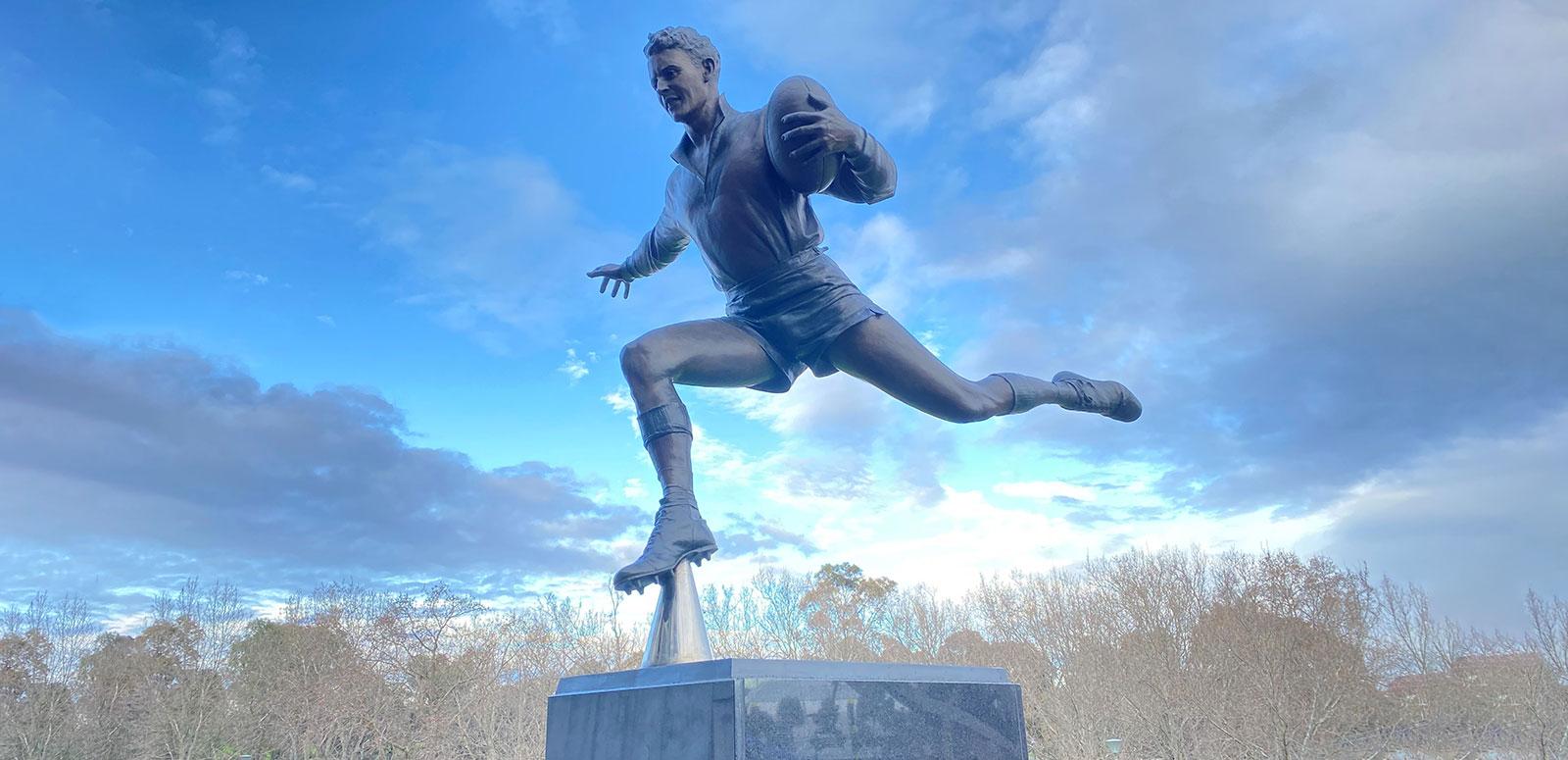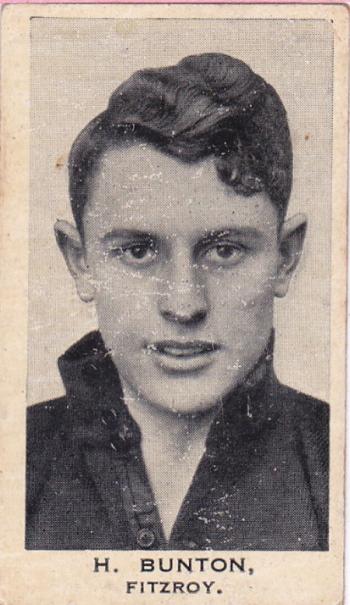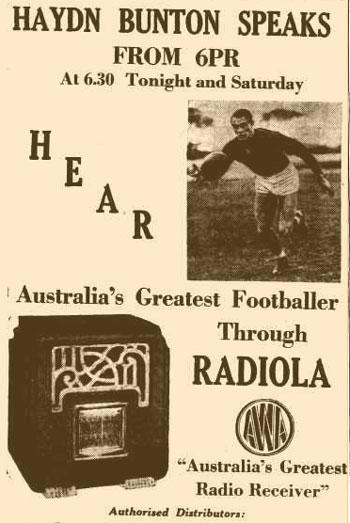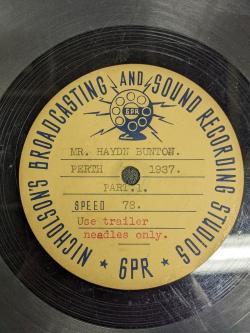Hear the only known recording of AFL legend Haydn Bunton, 'the Bradman of football', which has been rediscovered, preserved and released by the NFSA.

Hear the only known recording of AFL legend Haydn Bunton, 'the Bradman of football', which has been rediscovered, preserved and released by the NFSA.
Newspapers called him ‘the Bradman of football’. The most decorated of all Australian Rules footballers, Haydn Bunton dominated two league competitions in the 1930s.
Possessing great speed and uncanny ball sense, the champion rover collected three Brownlow Medals in Victoria and three Sandover Medals in Western Australia within a dozen seasons.
Tragically leaving behind two teenage sons in 1955 following a serious car accident in South Australia, Bunton’s passing at age 44 occurred just prior to the birth of television in Australia, robbing the next generations of football followers with the personal reminder of his deeds.
However, the recent discovery of several unique lacquer discs featuring a live 6PR Perth radio broadcast in August 1937 provides the first opportunity to hear the voice of a sporting icon, absent since his passing 67 years ago.
With his matinee idol good looks, superior fitness and humble disposition, Haydn Bunton enjoyed enormous popularity in the 1930s playing in the Victorian Football League (VFL).

The Age newspaper called him 'the first true star of Australian Rules' and 'by far the League’s most colourful personality'.
Bunton was an outstanding all-rounder at sports. In a ‘City versus Country’ cricket match, he and future test stars Don Bradman and Archie Jackson were singled out. But the Albury-raised teenager focused his natural abilities on football.
Debuting in 1931 as a 19-year-old player for the Fitzroy Maroons (now Brisbane Lions), the boom recruit instantly dominated, winning two Brownlow Medals, the award for the VFL’s highest individual honour, in his first two seasons. By August 1937, Bunton had added a third and was captaining the Victorian state team at the 9th Australian National Football Carnival being held in Perth.
In an exciting championship final watched by a packed crowd of 38,022 at Subiaco Oval, an attendance The West Australian declared 'was easily a record for a sporting fixture in this state', Victoria overcame a spirited Western Australian side by eight points (97 v 89). The crowd was so large that the fence collapsed with fans spilling out onto the boundary line, an astonished Bunton exclaiming 'it was something in football I’ve never seen before'.

That evening, on Saturday 14 August 1937, prior to the Victorian team’s return trip east by train, the skipper visited the studios of Perth radio station 6PR for the second of two appearances.
Giving an overview of the carnival, a gracious Bunton was effusive in his praise for both opponents and fans alike.
Whether for posterity, given the visiting footballer’s star power, the excitement of the day’s events or the opportunity for 6PR to test out its recently acquired lacquer disc cutting equipment, Bunton’s 6.30pm summary was recorded live to two single-sided 12-inch 78 rpm blank lacquer discs.
The surviving six-minute speech is slightly truncated because, with a limited recording time of three to four minutes per blank disc, a changeover from first disc to second would have ensured some words were not captured. Existing NFSA holdings and contact with 6PR suggest the footballer’s words here likely form the earliest known surviving station recording.
The discs are also among the earliest live Australian radio broadcasts in the NFSA collection. Bunton’s sons Haydn Jnr and David, when recently contacted, also believe this is the only known recording of their famous father.
In the years following, the pair of discs found their way to VFL (now AFL) headquarters in Melbourne, where they were boxed up, placed in storage and forgotten. Not even the AFL’s archives department were aware of their existence.

During the COVID-19 lockdown of 2021, the AFL decided to renovate their boardroom area and boxes that had been stored there were opened.
As the AFL’s Patrick Keane recalls, 'we were clearing all memorabilia that had been on display to go into storage, and then clearing out all cupboards of stationery, crockery and electrical items. Also in there were a couple of boxes which I hadn’t previously opened.'
Among scrapbooks and assorted football memorabilia from the 1940s to the 1970s were the two discs. As to how long these had been in the possession of the AFL Keane speculates, 'As best as I’ve been able to work out, the boxes moved from storage in the previous boardroom at the MCG to storage here [AFL HQ at Docklands], without anyone ever opening them. The discs could well have been with us for 30 to 40 years.'
With no means to play these unique discs, the AFL contacted the NFSA for our appraisal. Once we established the rarity of the material, our Audio Services team in Canberra examined and digitised the discs.
A lacquer disc, by its very fragile nature, degrades with each replay. The digitised results of the NFSA transfer indicate the discs, though exhibiting scratches and examples of ‘stitching’ (when a stylus has jumped across the surface), had not been played frequently in the intervening years.
Working from the raw digitised preservation files, NFSA Audio Technician Gerry O’Neill undertook a full audio restoration, removing much of the surface disc noise and boosting audio levels for a significantly improved listening experience.
As surviving footage of Bunton is equally rare, we have accompanied the newly discovered 1937 audio with Bunton’s sequences performing training drills for the instructional film How to Play Australian Rules Football (Bruce Andrew, 1936), recently digitised from the best surviving 16mm print in the NFSA collection.
Combining the two discs into a single audio file, this is the first time Haydn Bunton’s voice has been heard since 1955:
Audio courtesy Nine Entertainment. NFSA title: 1659051
Accompanying vision courtesy News Corp Australia and Estate of Bruce Andrew. NFSA title: 16391
In the 80 years since Haydn Bunton ran out for his last VFL game, no player has surpassed his Brownlow Medal feats, with only three other players matching his triple-award accolade.
In 1996, Bunton became an inaugural Australian Football Hall of Fame inductee, later elevated to Legend status, and selected in the forward pocket in the AFL Team of the Century.
In 2005, Bunton’s greatness was acknowledged in bronze, when he became the seventh of 17 (at the time of writing in 2022) Australian sporting icons to have had their statue unveiled within the MCG precinct. With both sons – Haydn Junior, himself an Australian Football Hall Of Fame inductee, and David – in attendance, Network Ten cameras recorded the significant event:
Haydn Bunton statue unveiled. Ten News Melbourne, 16 April 2005. Courtesy: Network Ten. NFSA title: 653065
The original discs have now been generously donated by the AFL and digital copies supplied to the AFL, 6PR and the Bunton family.
And for everyone else, this is the first chance in nearly decades to hear the voice of one of the first Australian Rules football superstars.
With thanks to the AFL, the Bunton family (Haydn, Maggie and David), Michael Roberts at the Collingwood Football Club, Graeme Dickenson, 6PR, Network Ten, News Corp Australia, Mike Sexton, Fran Thomas and Chris Donald’s biography Haydn Bunton – Best and Fairest (Pennon Publishing, 2003).
This article was first published in 2022. The text was updated in 2023.
Want to be the first to hear stories and news from the NFSA?
Subscribe to our newsletter and never miss out.
Main image: statue of Haydn Bunton at the Melbourne Cricket Ground. Photo by Simon Smith.
The National Film and Sound Archive of Australia acknowledges Australia’s Aboriginal and Torres Strait Islander peoples as the Traditional Custodians of the land on which we work and live and gives respect to their Elders both past and present.